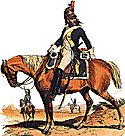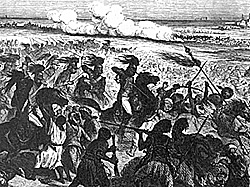Large Uniform Plate (very slow: 205K
Theoretically a Regiment of Dragoons comprised a staff and four squadrons each of two companies. The regimental staff mustered some twenty officers and men and the companies were each 100 officers and men, ten of the latter were to be on foot. This organisation, decreed on 21st February 1793, remained virtually unchanged into the Early Empire except for the increase in the proportion of dismounted dragoons.
"Theoretically" is, however, the important point here as the following master state of the Army's Cavalry Regiments, taken on 30th June 1798, shortly before the landing in Egypt, shows (the strengths are obviously "approximate" but do exclude "Officers" who, at full strength, would have added an additional 8 officers and 2 trumpeters per squadron):
Incidentally, the Light Cavalry mustered the following men in the same muster:
In addition to these 2760 men and possibly some 230 officers were some 120 to 130 mounted guides, [3] but the whole had only 530 horses! This shortage of horseflesh was seriously to hinder the French Army of the Orient throughout its Campaign in Egypt and was amongst the reasons behind the raising of the Regiments of Mamelukes, Syrians and Dromedaries. The problem was partly solved with time but the situation remained far from ideal throughout the stay of the French Army in the East. On 1st March 1800 [4] the total strength of the Dragoon Regiments of General Roize's Cavalry Division was:
The two light cavalry regiments, plus the Syrian and Mameluke cavalry numbered an additional 802 men and 608 horses. All figures are exclusive of officers and officers' mounts and probably of trumpeters too.
Uniform
The uniform of the French Dragoon Regiments was laid down by the "provisional" regulations of 1st April 1791 and remained essentially unchanged until the Regulations of 7th February 1812 (the "Bardin" Regulations). Even the "Kleber Ordinance" of 1st October 1799 which provided the infantry with their much noted coats of a great multitude of hues (including "lime green" and "purple") left the dragoons in their traditional dark green with the same facing colours as the 1791 regulations (although the footwear was changed, see below).
The 1791 regulations confirmed the Dragoon regiments in their dark green coats with facing colour lapels and turnbacks piped in dark green, shoulder straps of dark green piped in facing colours, and collars & cuff flaps in facing colours piped dark green or green piped in the facing colour in various combinations according to regiment - Table 1 shows the appropriate information for the Regiments with the Expedition. Pockets were piped in the Regimental facing colour and were horizontal or vertical according to Regiment (again see Table 1). The turnbacks bore a green grenade and the buttons were pewter embossed with the regimental number for all regiments. [5] The Dragoon helmet, well illustrated in Phillipoteaux's plate reproduced here, was brass with a black horsehair mane, a brown fur turban and a black leather peak. Chin scales and peak binding were also brass. [6] This dragoon pattern helmet was to remain essentially unchanged from 1786 until 1825.
The waistcoat was white and the breeches buff leather or buff lambskin - the former was supposed to last four years to the latter's one. However these breeches proved impractical in the Egyptian heat and from around mid 1799 they wore white cotton breeches. The 1791 pattern heavy cavalry boots are also well shown by Phillipoteaux but were replaced from June 1799 by more practical Hussar-style boots with white trim (silver for officers) -the sole uniform change of the Campaign.
The Dragoon's weaponry was a cavalry musket of the 1777 model, carried butt down on the left (its muzzle is just visible on the foreground dragoon), a pair of 1777 pattern pistols (although some dragoons may have been issued with the obsolete 1763 pattern because of shortages of weaponry), and a straight sword of either the 1783 pattern, with its fleur de lis replaced by a lictor's fascine, or of the Year IV pattern. Some dragoons, again because of shortages, may have been issued with the curved 1790 pattern Chasseur a Cheval pattern sabre. The black leather and brass scabbard was identical for all models and was worn on two white slings from a white leather waistbelt with a plain brass buckle. Incidentally Phillipoteaux's illustration is incorrect in this one minor area -the sword hilt shown is the Year IX pattern, not issued to the Army of the Orient.
The waistbelt also supported an infantry pattern bayonet on a frog at the left side. On campaign it was often the case that the waistbelt was worn over the right shoulder which with the white cartouch box belt gave the Dragoon a distinctly Eighteenth Century appearance. The cartouch box itself was of plain black leather with no pouch ornament.
The saddlery is perfectly shown in the colour plate and was the same for all regiments except that it was usual for the regimental number to appear in white on the end of the valise. Curiously the grenade in the rear corner is shown at 90ø to its normal positioning with the burst angled toward the saddle. [7]
Officers' uniforms were identical to those of their men except for the replacement of white lace by silver and the omission of the musket and its accompanying cartouch box. The turnback ornaments were silver, as were the rank epaulettes.
Trumpeters and Drummers of Dragoon Regiments were not subject to any specific dress regulations from the abandonment of the Royal Lace until the imposition of Imperial Livery on 30th December 1811. In the interim Regimental musicians wore a multitude of uniforms mainly based around the famed "reversed colours" whereby the coat was of a facing colour with green facings - but there were a vast number of variants, changing almost from issue to issue and dependent solely on the whim and pocket of the Regimental Colonel.
For service on foot the uniform was identical except for the replacement of the boots, by O.R.'s at least, by black gaiters as worn by the infantry.
There were no elite companies in Revolutionary Dragoon Regiments - they were not introduced until 24th September 1803.
Barthorp, M. Napoleon's Egyptian Campaigns, 1798-1801, London 1978 ISBN-0-85045-126-4
This article appears in MagWeb (Magazine Web) on the Internet World Wide Web. The bulk of Bonaparte's cavalry in the "Egyptian Adventure" of 1798-1801 was composed of 14 squadrons from five Regiments of Dragoons,[1] the 3rd, 14th, 15th, 18th and 20th, [2] all but the 14th Veterans of the General's 1797 Italian Campaign.
The bulk of Bonaparte's cavalry in the "Egyptian Adventure" of 1798-1801 was composed of 14 squadrons from five Regiments of Dragoons,[1] the 3rd, 14th, 15th, 18th and 20th, [2] all but the 14th Veterans of the General's 1797 Italian Campaign.
3rd Dragoons 2 squadrons 360 men
14th Dragoons 3 squadrons 600 men
15th Dragoons 2 squadrons 200 men
18th Dragoons 4 squadrons 400 men
20th Dragoons 2 squadrons 350 men
7th bis Hussars 3 squadrons 600 men
22nd Chasseurs a Cheval 3 squadrons 250 men
3rd Dragoons 225 men, 225 horses
14th Dragoons 322 men, 245 horses
15th Dragoons 181 men, 129 horses
18th Dragoons 190 men, 115 horses
20th Dragoons 293 men, 233 horses
 Officers Uniforms
Officers Uniforms
FACING COLOURS OF THE DRAGOONS IN EGYPT Regiment Lapels &
TurnbacksCollars &
Cuff flap*Cuffs Pockets 3 scarlet scarlet green horizontal 14 pink green pink horizontal 15 pink pink green horizontal 18 pink pink green vertical 20 yellow green yellow horizontal * cuff flaps suppressed on the Kleber Ordinance coats Footnotes:
[1] The force also included the 22me Chasseurs a Cheval and the 7th bis Hussards (composed of squadrons from the 2nd and 7th Hussars). I have not covered these two regiments here, but they will be the subject of a future article.
[2] Despite the presence of these regiments one recent, noted historian wrote that "There with no heavy cavalry" with the Army. Another comment on the Dragoons and Heavy Cavalry debate . . . .
[3] The forerunners of the Chasseurs a Cheval of the Consular and Imperial guard and, like these latter, commanded by Bessieres.
[4] Bonaparte had taken his leave of the Army of Egypt in September 1799, on 9th October he arrived back in France.
[5] Brass and pewter buttons were used as a form of currency in the Army in Egypt and so no doubt rapidly disappeared from coats. Their replacement was probably the cloth buttons as on the infantry coats of the Kleber Ordinance.
[6] It was not usual for O.R.'s to wear plumes on campaign, but the regulation called for a black plume with its upper third of facing colour. However very many regimental variations are recorded.
[7] Rigo (see sources) states that from the Kleber Ordinance the Dragoon other ranks adopted the sheepskin half shabraque of the Hussars with the regimental number in the rear corner.
PRINCIPAL SOURCES
Ede-Borett, S. The French Campaign in Egypt 1798-1801, in Wargames Illustrated 34, 35 & 36, Newark 1990
Malibran, H. Guide a l'usage des artistes et des costumiers, Paris ND
Marrion, R. Equipment of the French Army in Egypt 1798-1801, in Tradition Nos 42, 43 & 47, London 1972
Petard, M. Les dragons du Premier Consul : in Tradition Nos 73 & 74, Paris 1993
Rigo, Le Plumet, 14e regiment, etendards en Egypte 1800-1801, Pl 209
Back to Empire, Eagles, & Lions Table of Contents Vol. 2 No. 13
Back to EEL List of Issues
Back to MagWeb Master Magazine List
© Copyright 1995 by Emperor's Headquarters
Other military history articles and gaming articles are available at http://www.magweb.com